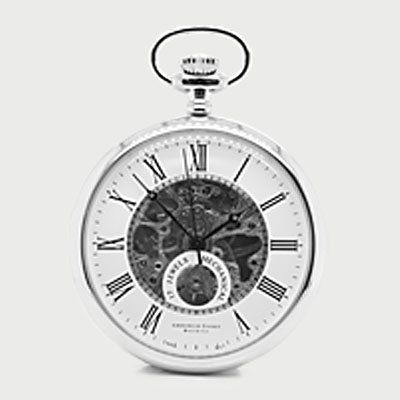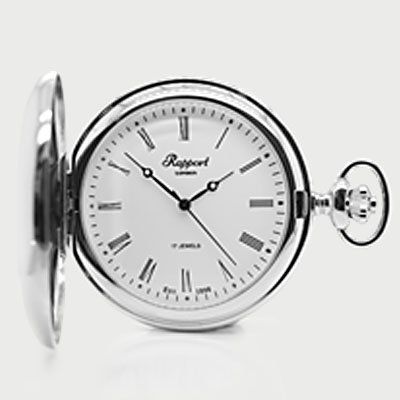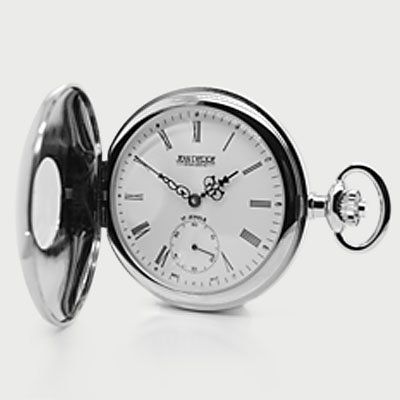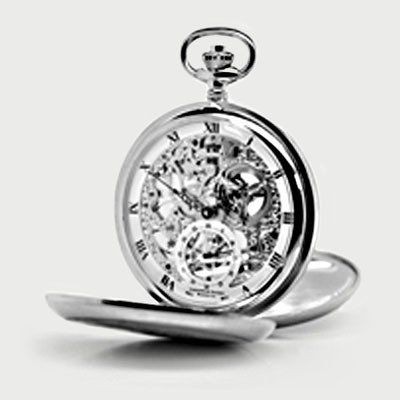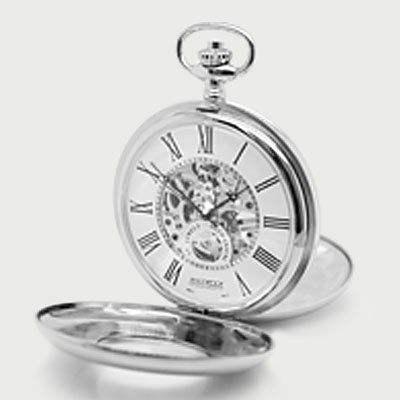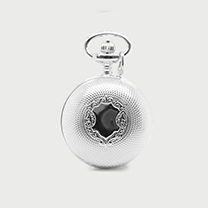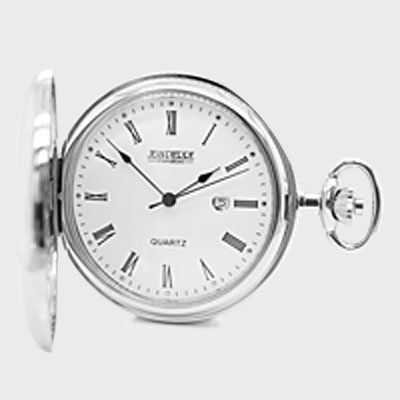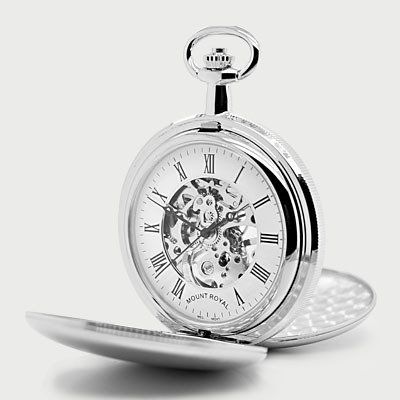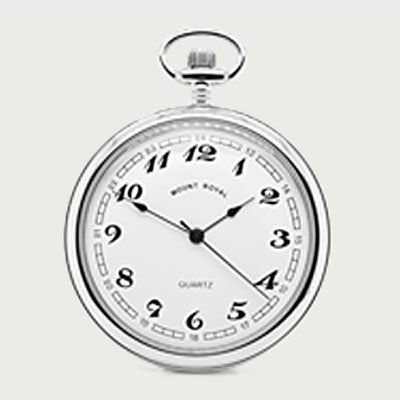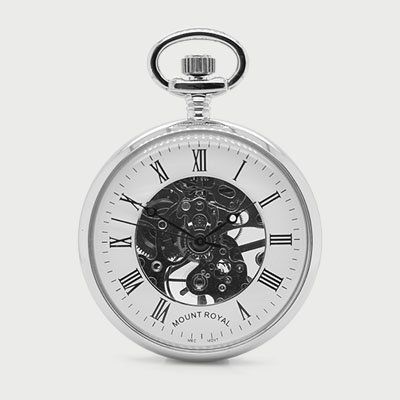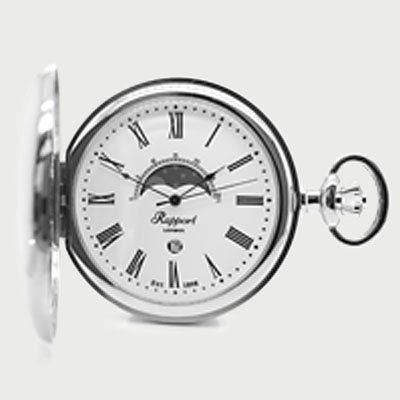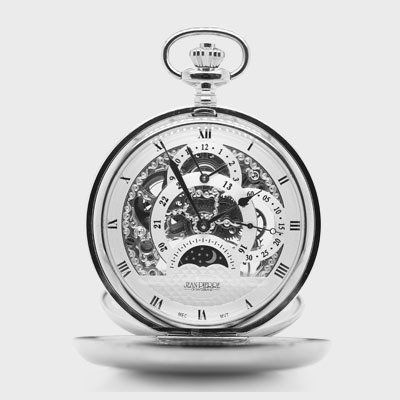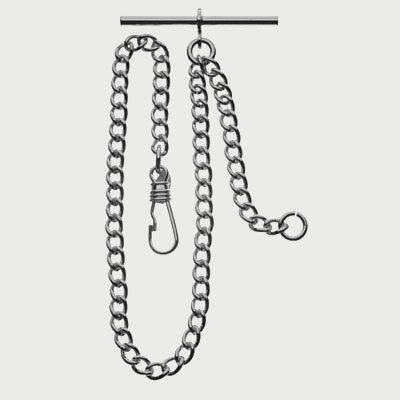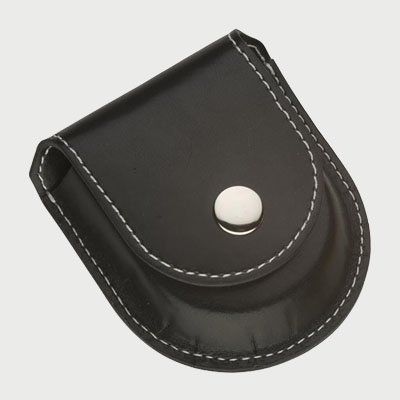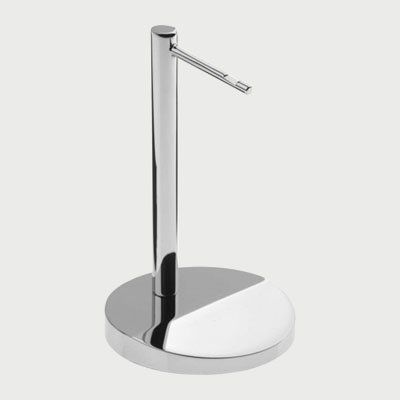GLOSSARY OF POCKET WATCH PARTS & TERMINOLOGY
Over the last few centuries, Pocket Watches have developed a language all of their own. It can be a bit daunting when confronted with a sheaf of information about a watch, only half of which makes sense. We hope that the following list of pocket watch words and phrases will help throw some light on this intriguing part of horology. [horology: noun a) the science of time measurement. b) the art of making timepieces, clocks and watches. From the Greek "hora"]
A
Acrylic Crystal
Crystal is the traditional name for the transparent cover of the dial that used to be made from glass (mineral crystal) or sapphire. Acrylic Crystals are made from clear synthetic plastics like Hesalite - these are shatterproof and have less inherent glare than glass and sapphire..
Albert
Probably named after Prince Albert, this is a chain attached to the pocket watch that attaches to a waistcoat buttonhole or lapel buttonhole with a T-bar. A Double Albert has two chains extending from the T-bar - the pocket watch goes on the end of one chain in the lefthand waistcoat pocket whilst the other chain can have a cigar cutter, signet, key or Vesta box attached and is placed in the righthand waistcoat pocket. An Albert is sometimes referred to as a "Fob", although, more accurately, a Fob is an ornament or medallion hung from the chain that is in view and not in the pocket.
Amplitude
The angle of oscillation of the Balance Wheel. The number of degrees it travels from one end of its rotation to the other. The amplitude of the majority of watches is between 270 and 320 degrees. This is also a term for the speed of the Balance Wheel (see Frequency)
Anchor
Rocking from side to side, the Anchor controls the movement of the Escape Wheel to one cog at a time … that's the ticking sound….
Arbor
The shaft on a gear, pinion or wheel
B
Balance Wheel
The most visibly moving part of the watch, this is the wheel that rotates quickly back and forth. The balance wheel derives it's impetus from the Hairspring.
Belt Chain
An alternative to an Albert, a belt chain is used if you want to keep the watch in your trouser pocket. The chain has a clip that attaches to the trouser belt above the pocket.
Bezel
This is the metal ring that holds the Crystal in place. It is usually screwed or clipped onto the body of the watch.
Blue Screws
More for decoration than for any practical purpose, these are screws that are discoloured blue either through heat treatment or electrical anodising - a similar colour to gun metal.
Bow
The loop or metal ring at the top of the Stem around the Crown used to clip a chain or Albert to the watch.
Bridge
A watch mechanism can be divided into two or three different sections depending on function. These are called "Bridges". The Mainspring Barrel can be housed in the Barrel Bridge, whilst the Balance Wheel sometimes housed separately in the Balance Bridge.
C
Case
The metal part of the watch that houses the movement. Often gold plate, silver, brass or chrome, the case comes in a variety of designs from Hunter to Half Hunter, Double Hunter (twin-lidded) and Open Dial. Plain cases are commonly engraved, whilst others have ornate engined turned or hammered finishes.
Chapter Ring
On the outer edge of the Dial, this is a ring that marks the hours and minutes, so called because the hour marks were referred to as Chapters.
Crown
The knob used for winding and adjusting time at the top of the winding stem. Sometimes called the Winder.
Crystal
The traditional name for the Glass - the clear cover of the dial originally made from glass (mineral crystal) or sapphire, but now more commonly made from Acrylic Crystal
D
Damascening or Damaskeening (USA)
An American word for the elaborate, ornate engraving on a watch movement - similar to Guilloche, but the design is cut through an upper plated surface of a different coloured metal (European name: Geneva Stripes).
Dial
The watch face usually marked with numbers (or indices. batons & bars) to divide the 360 degrees into hours and minutes, Sub-Dials showing additional data are called Registers.
E
Ebauche
A basic Movement often purchased by a watchmaker from an outside manufacturer and then embellished and branded.
Escape Wheel
A notched wheel whose teeth alternately engage and disengage with the Anchor. Tick, tick, tick ...
Escapement
This is what translates the power in the Mainspring to timekeeping. The Escapement includes all those elements that regulate the Mainspring power from the Barrel to the Hairspring, Balance Wheel and Anchor.
F
Frequency
How many times the Balance Wheel reaches the end of a rotation (in either direction - one oscillation back and forth equals 2).
Gear Train / Wheel Train
The series of Wheels and Pinions that transfer the power in the Mainspring to the Escapement. It scales up the speed of rotation of the Mainspring Barrel, which in turn increases the length of time the watch can operate between winds.
Geneva Stripes
The European term for Damascening - the decorative patterning of a watch Movement. Also called Fausses Cotes or Cotes de Geneva (see Damascening)
G
Glass
Another name for the Crystal - the clear cover of the dial originally made from glass (mineral crystal) or sapphire, but now more commonly made from Acrylic Crystal
Guilloche
A repetitive decorative technique used on Dials and Cases. Either through engraving, embossing or engine turning, the decoration catches and refracts the light giving depth to the surface. Often used for a "sunburst" or solar pattern on the surface. Often used to add interest to the centre of dials.
H
Hairspring
The coil of fine metal attached to the Balance Wheel. The spring, by expanding and contracting, gives the Balance Wheel the impetus to rotate back and forth driven by the power from the Mainspring. The Hairspring performs the same role as a pendulum in a clock.
Half Hunter (Demi-Hunter) Case
A hunter watch with a circular window cut in the lid covering the dial which allows the time to be read through the window, without opening the watch. The lid often has the hours engraved or pressed into the metal to make reading the time easier.
Hunter Case
A watch with a front cover or sprung lid to protect the Crystal and Dial. The lid or cover is usually sprung and released by pressing the Crown on the Stem.
I
Incabloc
Visible on skeleton watches, this is a spring-loaded mounting system for the Jewels on the Balance Wheel that provide shock protection if a watch is dropped. If you locate the Balance Wheel, have a close look at the Jewel holding it in place and you will see a "Lyre" shaped spring clip retaining the Jewel in position - this is the Incabloc.
Indices or Index
The marking on a dial to break up the degrees into hours and minutes. Also placed around the Chapter Ring.
J
Jewels
Usually made from synthetic ruby, but also made from sapphire, diamond and glass, Jewels are used as bearings for all the shafts, gears, arbors and moving parts of the watch. Using Jewels reduces the friction and therefore increases the accuracy and lifetime of the watch. Jewels have no intrinsic value as precious stones and 17 Jewels on a mechanical watch indicates a quality movement - any more is usually superfluous horological bling.
L
Luminova
A glowing phosphorescent pigment used to make the markings on a watch dial readable in low light or in the dark. It acts like a battery, storing light and then emitting it in darkness. The benefit over Tritium is that it doesn't age and can repeat the process for years …. however you do need the initial "charge" from a light source, whereas Tritium generates its own power.
M
Mainspring & Mainspring Barrel
This is the chunkier spring in the mechanism. This is the one that stores the power when you wind the watch. You coil the spring as you wind the watch and this slowly unwinds to give power to the Balance Wheel through the rotating Mainspring Barrel
Moonphase
An aperture displaying a dial indicating the phase of the moon for new to full - waxing and waning.
Movement
The basic workings or mechanics of the watch whether it be mechanical or quartz … if you take away the Case, you are left with the Movement. Many movements are purchased as "Ebauche" by watchmakers and then refined
Mineral Crystal
The glass transparent covering (Crystal) of the watch dial. Commonly replaced by Acrylic Crystal in modern watches and Sapphire Crystal in high-end watches.
N
Nivarox
The trade name for a metal alloy developed mainly for watch springs and critical components. The name comes from a German acronym for "Nicht Variabel Oxydfest (Ni Var Ox)" meaning non-variable and non-oxidizing. The fact that the alloy is rust-proof, non-magnetic and isn't affected by temperature changes means it is the perfect material to maintain consistency and accuracy in a watch.
O
Open Dial
A pocket watch with no lid or metal cover to the Crystal and Dial.
"O" Ring
A seal on some watches to increase water resistance.
P
Pinion
Smaller gears in the Movement which are solid - as opposed to Wheels which are usually spoked.
Power Reserve
Of mechanical watches, this is the amount of time the watch can run when fully wound. Even if your watch has a 48 hour of a 72 hour Power Reserve, it is good practise to get into the habit of winding your watch each morning.
Q
Quartz Movement
An electronic, usually battery-powered, movement that uses the vibrations of known frequency from a quartz oscillator to determine the time. A very accurate and less expensive alternative to a mechanical movement.
R
Register
A sub-dial or second dial on the main dial, sometimes showing seconds, but more usually the day, date or moon phase. Some chronometer style watches have many Registers.
Regulator
On some watches, a Regulator is used to adjust the speed or Frequency" of the balance wheel. Marked "Fast" and "Slow", or "Advance" and "Retard", the Regulator allows you to adjust the timing of the watch for accuracy.
Repeater
A watch that chimes the hours and quarters - usually highly intricate and never cheap.
S
Sapphire Crystal
A very hard and transparent synthetic form of sapphire used as a watch glass or Crystal. Very scratch-resistant, it has a value of 9 on the Mohs scale of mineral hardness. To give you an idea of its strength, it is used in the shatter proof windows of armoured vehicles.
Second Time Zone
An additional Register dial that shows the time in a different time zone.
Sidewinder
This is a watch where the Stem emerges from the watch at 3:00 rather than at 12:00. This is pretty common with Hunter Cases because it makes the time easier to read when you open a Hunter - as you hold it in your right hand and press the Stem with your thumb to open the lid, 12:00 ends up naturally in the correct uppermost position.
Skeleton Watch
A watch with the Movement on display. The Dial consists of only the Chapter Ring with the hours and minutes around the outside, the rest is clear allowing you to see the Movement, Balance Wheel, Jewels etc … Some Skeleton Watches have Crystal backs to allow the Movement to be viewed from both sides.
Stem
The shaft that sticks out of your pocket watch with the Crown on the top … thus a Stem Wound watch.
Sub-Dial
Another name for a Register
T
Tourbillon
A clever addition to the Escapement to help maintain accuracy, a Tourbillon counters the effects of changes in the position/angle of the watch. It allows the escapement to rotate independently within the watch so that it maintains a consistent position in relation to gravity. First developed in the 1790s, Tourbillons are not really necessary in modern watches, but they are still popular in high-end watches as a demonstration of skill and technical ability.
Tritium
A self-powered light source based on an isotope of Hydrogen used to make the markings on a watch dial legible in the dark. It is not a radiation hazard since it is a low energy beta emitter, but it has been superseded in most watches now by more natural pigments like Luminova. With a half life of just over 12 years, Tritium will slowly fade and be pretty ineffective after 25 to 30 years.
W
Wheel
The larger gears in a watch which are often spoked. Solid smaller gears are called Pinions.
Winder
Another name for the Crown. The knob used for setting the time and winding the spring.
Z
Zulu Time
The military and aviation name for Greenwich Mean Time (GMT) or Coordinated Universal Time (UTC) working on a 24 hour clock where the Greenwich Meridian is in the zero (Z) hours time zone. Since in the NATO phonetic alphabet "Z" is "Zulu", pilots and military operations work to "Zulu Time" - a constant wherever they are in the world. And here's a tip - Reykjavik is always on Zulu Time because the Icelanders never change their clocks forwards or back and they run to GMT (even though they are nearly 22 degrees West).



